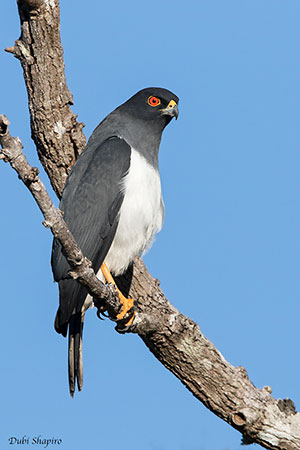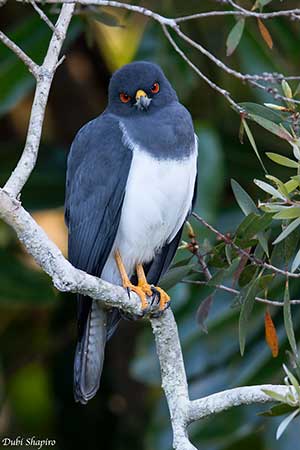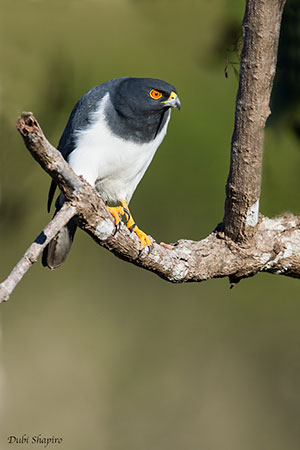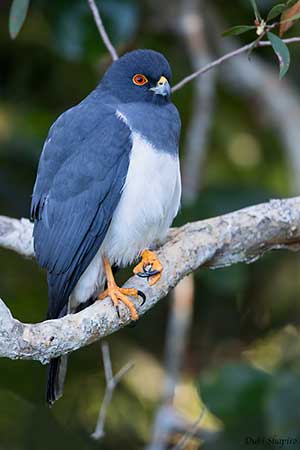
Fr: Autour à ventre blanc
Ang: White-bellied Goshawk - New Caledonia Goshawk
All: Weißbauchhabicht
Esp: Gavilán de Nueva Caledonia
Ita: Astore di New Caledonia
Nd: Nieuw-Caledonische Havik
Sd: nykaledonsk hök
Photographer:
Dubi Shapiro
Dubi Shapiro Photo Galleries & Dubi Shapiro's Pictures on IBC
Text by Nicole Bouglouan
Sources:
HANDBOOK OF THE BIRDS OF THE WORLD Vol 2 by Josep del Hoyo-Andrew Elliot-Jordi Sargatal - Lynx Edicions - ISBN: 8487334156
RAPTORS OF THE WORLD by James Ferguson-Lees et David Christie - Helm Identification Guides – ISBN: 0713680261
Global Raptor Information Network - Working to Conserve Birds of Prey in nature
Le Portail de la Biodiversité en Nouvelle Calédonie – Ecosystèmes terrestres
White-bellied Goshawk
Accipiter Haplochrous
Accipitriformes Order – Accipitridae Family
INTRODUCTION:
The White-bellied Goshawk is an elegant raptor endemic to New Caledonia and offshore islands. This medium-sized bird of prey has black-and-white plumage, but some rare individuals may have whole throat and breast also white.
It feeds on lizards, large insects, small rodents and some birds. It frequents the dense humid forest and edges in lowlands and hills.
The White-bellied Goshawk has restricted range on a single small island. It is affected by persecution because it kills domestic chickens, and in next future by habitat loss. The species is currently classified as Near Threatened.
DESCRIPTION OF THE BIRD:
Biometrics:
Length: 32-40 cm
Wingspan: 58-74 cm
Weight: M: 152-218 g – F: 227-281 g
The White-bellied Goshawk has blackish-slate plumage but the head is darker, whereas throat and breast are paler than rest of plumage. Tail and wing tips are dark grey.
On the underparts, belly, thighs, undertail-coverts and underwing are white. The secondaries and the undertail are pale grey with narrow dark grey bars. The chin area may appear slightly speckled.

The bill is dark bluish-grey with yellow to dusky cere. The eyes are red, surrounded by narrow yellow eyering. Legs and feet are yellow with strong, black talons.
Male and female have similar plumage, but the female is larger and heavier than male.
Some individuals may have white throat and breast, but they are rarely seen.
The juvenile has mottled and streaked brown and creamy-white plumage. The upperparts are darker than the underparts. The eyes are yellow.
RANGE:
The White-bellied Goshawk is endemic to New Caledonia. It occurs from the far north at Manjelia, to the far south at Goro.
HABITAT:
The White-bellied Goshawk frequents dense rainforest and forest edges. It is more widespread in humid forest than in degraded forest. However, it can be seen foraging in tall maquis of 2-4 metres high, and in savanna woodland, more rarely in dry forest, mangrove and cultivated areas.
CALLS AND SONGS: SOUNDS BY XENO-CANTO
The White-bellied Goshawk gives fast, high-pitched “tseee-tseee-tseee”.

BEHAVIOUR IN THE WILD:
The White-bellied Goshawk feeds primarily on lizards, large insects (beetles, grasshoppers and other species), and small mammals, mainly rodents (mice and rats). It also takes some birds including parakeets, pigeons and domestic poultry.
It hunts from perch but also chases birds in flight. It takes the prey on the ground, often in rocky areas, bushes, foliage and tree trunks.
It is persecuted by humans because it often eats domestic chickens, giving the bird its local name “Katabeialek” or “eater of small chickens”.
The breeding behaviour of the White-bellied Goshawk is poorly known. From some observations, aerial displays were seen in September, but not described, and a female was carrying sticks to an almost finished nest in early October. This species usually occurs alone or in pairs.
The White-bellied Goshawk is non-migratory, but the juveniles disperse from the breeding sites after the reproduction.
The flight of Accipiter species is often undulating with some dives. They are usually powerful fliers, alternating wingbeats and glides. They soar within the forest, allowing branches and tree trunks.

REPRODUCTION OF THIS SPECIES:
Nesting activities are recorded from September to December in New Caledonia, with aerial displays noted in September.
The White-bellied Goshawk builds a nest in tree, typically made with twigs. An almost completed nest was observed in early October. It was placed about 12 metres above a dry streambed, and built on a large, horizontal branch in tall tree. In December, numerous debris including rodent bones and fur were seen below the nest, indicating nesting success.
Three eggs dull white with pale reddish blotches were collected, but we do not known if these eggs may or may not have formed a single clutch. Usually, these raptors lay two eggs.
No more information.
PROTECTION / THREATS / STATUS:
The White-bellied Goshawk has very restricted range on a small island where the habitat is progressively degraded. In addition, this raptor is subject to intense persecution by humans because it takes domestic chickens, but it is also killed for food.
The population is roughly estimated to number 1,500/7,000 mature individuals, and is suspected to be slowly declining.
The White-bellied Goshawk is currently classified as Near Threatened.
